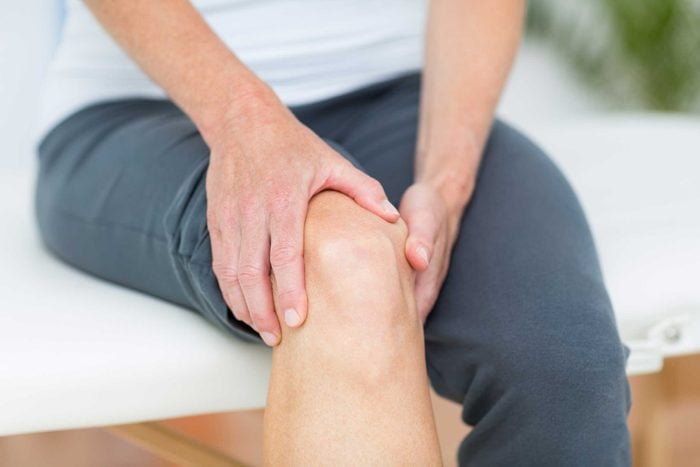
Is your leg pain serious?
“The key [with leg pain] is the context,” said Casey Humbyrd, MD, chief of the foot and ankle division of orthopedics at Johns Hopkins University, in Baltimore. “If someone just got off a plane and says ‘My leg hurts,’ go to the hospital. We truly see a spike in deep vein thrombosis (DVT) during holiday travel season. Of course, many other kinds of leg pain are just signs of overuse and respond to ice and anti-inflammatory [pain medications].” (DVT occurs when there is a blood clot in a vein, often in the lower limbs.)
Only physicians can truly diagnose leg pain causes, though, so if home treatment doesn’t ease discomfort fairly quickly, seek medical advice.

Shin splints
If you have pain in the front of the leg or knee, this is often a sign of shin splints and is almost always related to overuse. That is especially true when people begin or rapidly increase exercise or activity. “You often hear people say ‘I just started walking [or running] and started out at about three miles a day,'” says Dr. Humbyrd. “Their bodies aren’t ready for that increase in activity. “Rest your legs, use ice to reduce swelling, and take anti-inflammatory painkillers,” she advises. Ensure splints don’t become stress fractures by maintaining appropriate vitamin D levels, says Dr. Humbyrd. Ask your physician to test your vitamin D levels and discuss how to best increase them if they are at low levels.
Watch out for the silent signs you aren’t getting enough vitamins.
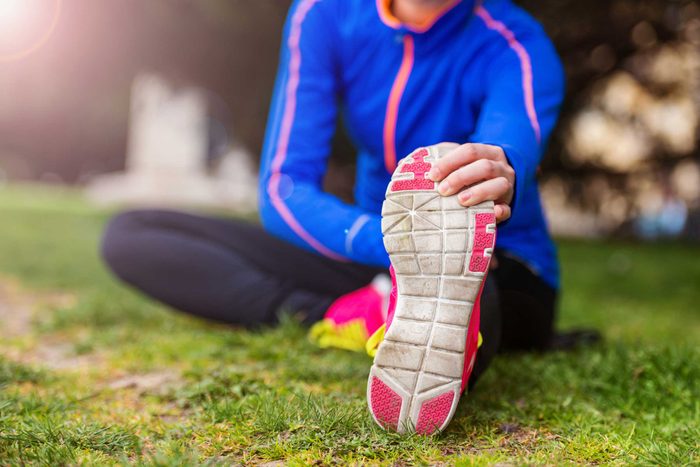
Leg cramps
Spasms or cramps in the leg muscles that don’t relax for at least several seconds may be caused by overuse or dehydration, says John-Paul Rue, MD, an orthopedic sports medicine surgeon at Mercy Medical Center in Baltimore. Sometimes even just walking much longer than usual may trigger leg cramps. Routine muscle cramps generally last just a few seconds or minutes and ease with warmth, rest and stretching, he says. But, he says, it’s important to distinguish between those and deep vein thrombosis (DVT). “The DVT usually presents with more deep-seated constant pain and swelling,” he says. If you suspect you have any symptoms of DVT, seek immediate medical attention. Another cause of ongoing pain and cramping in the legs could be peripheral artery disease, a clogging of the arteries (much like heart disease) that can reduce circulation to the limbs.
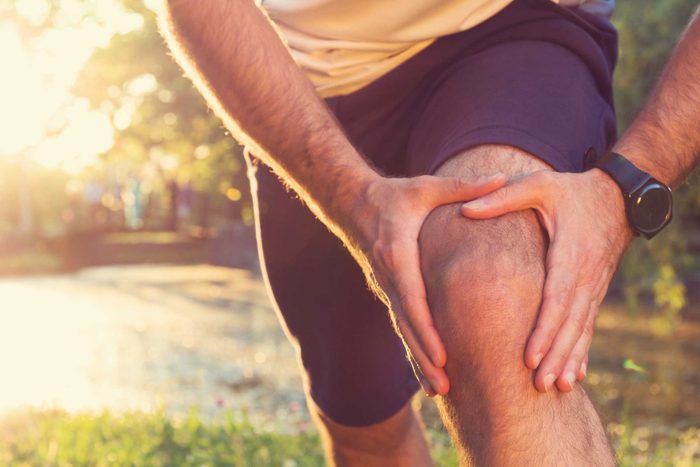
Knee pain
If the knee pain increases when you move the joint or press on it or the joint is swollen or looks red, you may have bursitis, says Dr. Rue. Rest, ice, and over-the-counter pain relievers can treat bursitis and help you deal with knee pain at home. It’s also advised to cushion your knees if you need to repetitively kneel or if the knee is in contact with hard surfaces. If the pain and swelling don’t respond or worsen despite in-home treatments, Dr. Rue recommends seeking medical treatment.
Check out these science-backed natural home remedies for arthritis pain relief.
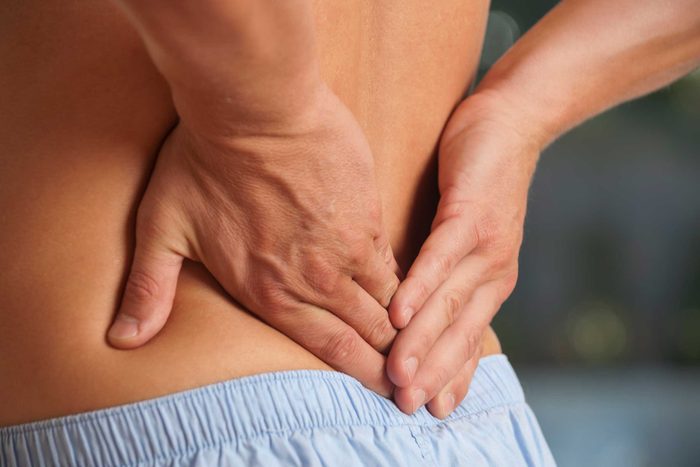
Sciatica
A shooting pain down the back of the leg may be caused by pressure on the sciatic nerve that runs from the lower back through the buttocks and into the legs. “We see that in gentlemen who carry heavy wallets in the back pocket of their pants,” says Dr. Rue. Relieve the pressure on the nerve (lighten the wallet) and the pain will often heal.
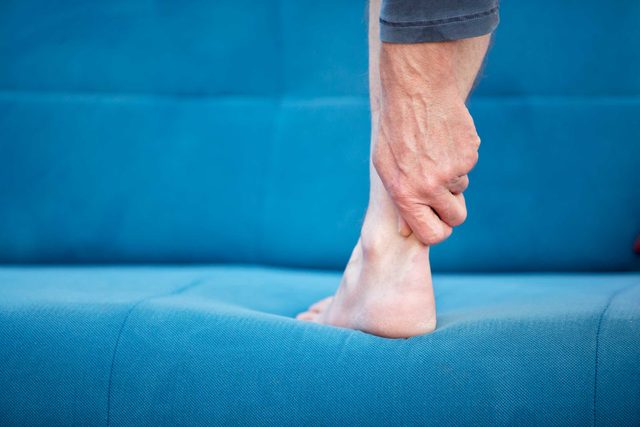
Achilles tendon injury
Pain above the heel bone is a common sign of an Achilles tendon injury, one of the most common leg pain causes, says Dr. Humbyrd. Wearing high heels and overuse can cause these injuries, especially for people with flat feet. Rest and ice can help the tendon heal. Don’t make the mistake of ignoring the pain and continuing running, power walking, or doing other exercises or athletics. If you ignore the pain, you may rupture the tendon, an injury that may require surgery. “It’s important for people to listen to their bodies and pay attention to the warning signs,” Dr. Humbyrd says.
Make sure to follow these pain management tips from Canadian physiotherapists.
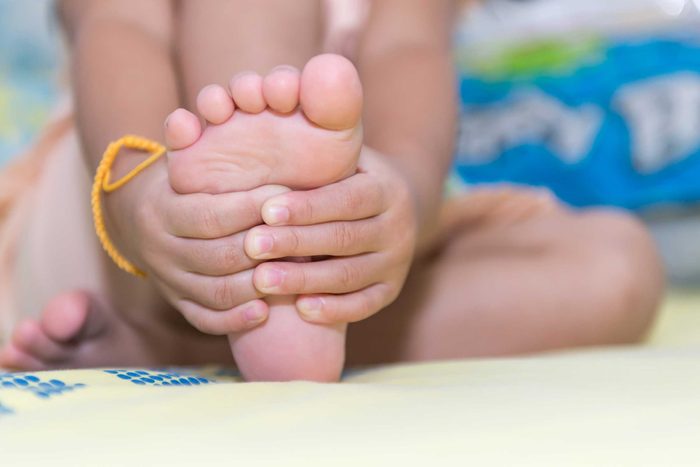
Growing pains
Children often awaken with severe leg cramps and leg pain. Many people well remember the terror of that pain and how difficult it was to ease it. “I’ve had my kids go through these and they’re usually associated with growth spurts,” Dr. Rue says. As the child’s bone grows, the muscle tendons stretch, causing pain where they attach to the bone. Ice, pain relievers, and stretching can lessen the incidents, says Dr. Rue.
Talk to your doctor if you experience any of these other serious health symptoms.

Thigh pain
Construction workers, police officers, and others who wear heavy belts often complain of thigh-specific leg pain. The reason may be that the belts cause pressure on a nerve that surrounds the hip. The pain radiates down the thigh, says Dr. Rue. The long-term solution is to lessen the weight of the belt to relieve the pressure on the nerve.
Learn about the surprising causes of chronic back pain.